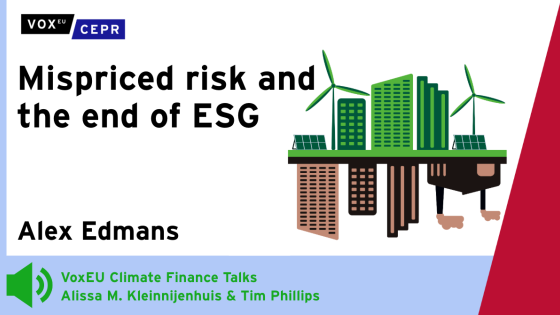The slow progress in climate-change mitigation policies aimed at reducing greenhouse-gas emissions has fuelled the discussion about alternative policy options in order to cope with the impacts from climate change. The better known one is adaptation, but most recently ‘climate geoengineering’ has begun to attract increasing attention. Geoengineering counteracts the temperature increase caused by climate change, e.g., by deliberately reducing incoming solar radiation (known as Solar Radiation Management). Preliminary research has shown that Solar Radiation Management could be a cost-effective solution since it can reduce the effects of global warming in a matter of just a few years (Matthews and Caldeira 2007). This fast action distinguishes Solar Radiation Management from traditional policies such as mitigation, and has led many to wonder whether this could turn out to be a feasible strategy should the damages of climate change turn out to be higher than expected.
The most widely discussed strategy of reducing solar radiation is through stratospheric aerosols. The reduction in solar radiation after volcanic eruptions have provided natural ‘experiments’ as a basis for this strategy. In 1991, the eruption of Mount Pinatubo led to the injection of around 20 megatons of sulphur dioxide into the stratosphere leading to a decrease of global temperature of about 0.5°C in the years after the eruption (Soden et al. 2002). Based on these experiences, a large scale Solar Radiation Management geoengineering scheme could offset global warming at a fraction of costs of abatement of greenhouse-gas emissions (McClellan et al. 2012). It thus provides a potential game-changer for climate policy which has led to a polarising debate, focussing on the cost-efficient potential to offset climate change and the political difficulties in climate-policy negotiations on the one hand, or on the potentially severe consequences such as increased ozone depletion and continued damages from a higher CO2 concentration on the other.
Economists and geoengineering
Economists have contributed to the debate about risks and virtues of geoengineering, unsurprisingly finding mixed results and mostly relying on numerical simulations, see (Klepper and Rickels 2012) for an overview. The fundamental driver of the divergence of opinion in this debate reside in the assumptions about relative costs, damages, and the uncertainty about the parameters characterising geoengineering (Sterck 2011). Very few papers, though, have provided an explicit modelling of the uncertainty of geoengineering, with the exception of Moreno-Cruz and Keith (2012). In recent research (Emmerling and Tavoni 2013), we use standard economic models of dynamic decision theory under uncertainty in order to assess the optimal climate policy under uncertainty with geoengineering. We deliberately take an optimistic view about the costs of geoengineering vis à vis with abatement to study how much abatement should still be implemented even with a geoengineering option available in the future.
New research
We analyse the optimal climate policy by means of abatement and geoengineering, where the latter is only available in the future and with uncertainty characterising both the uncertainty of geoengineering as well as the climate. Our results suggest that under fairly general conditions, today’s mitigation effort is decreasing but concave in the probability of success of geoengineering. Geoengineering does provide an alternative to abatement, but the uncertainty around its effectiveness makes abatement today respond slowly to the probability of success of geoengineering. The following graph illustrates the results for a reasonable calibration. If geoengineering were a certain option in the future, optimal abatement in the short run would be very low as soon as the effectiveness of geoengineering is slightly above zero, as shown by the green curve. Under uncertainty (brown curve), however, the curve is concave in the probability of geoengineering showing a rather ‘flat’ relation as long as the probability of geoengineering being implemented and effective is not close to one. This shows that significant abatement reductions are optimal only if Solar Radiation Management is very likely to be effective.
Figure 1. Share of first-period abatement of ‘business as usual’ emissions for different probabilities of geoengineering
We also investigate the potential insurance effect of geoengineering modelling uncertainty on both geoengineering and the climate response, and are able to confirm the results for reasonable correlation structures between the climate and the effect of geoengineering. An ‘insurance’ effect arises only if the relatedness between geoengineering becoming effective and severe impacts from climate change is very high and moreover if the probability of Solar Radiation Management becoming a viable option is large enough. The overall results are moreover confirmed using a full-fledged integrated assessment model (‘WITCH’) for a wide range of parameters specification.
Conclusions
Our research provides a strong argument for maintaining mitigation policies even when considering a very optimistic viewpoint on the potential of geoengineering. Even if we were to attach a 50% probability to the possibility that geoengineering will work at large scale, at low costs and with no side effects, the optimal carbon tax today should decrease only from 29 $/tCO2 to 19$/tCO2 if geoengineering is possible. While further research is a prerequisite to assess whether there will be a viable geoengineering option at some point in the future, the results suggest that for the time being, geoengineering does not warrant to be taken as a reason to significantly delay abatement effort from an economic point of view, even under optimistic scenarios about its feasibility and acceptability.
References
Emmerling, J and Tavoni, M (2013), “Geoengineering and abatement: a “flat” relationship under uncertainty”, FEEM Nota di lavoro No. 2013/31, Milan, Fondazione ENI Enrico Mattei.
Klepper, G and Rickels, W (2012), “The Real Economics of Climate Engineering”, Economics Research International, 1–20.
Matthews, H D and Caldeira, K (2007), “Transient climate-carbon simulations of planetary geoengineering”, Proceedings of the National Academy of Sciences, 104(24), 9949–9954.
McClellan, J, Keith, D W and Apt, J (2012), “Cost analysis of stratospheric albedo modification delivery systems”, Environmental Research Letters, 7(3), 034019.
Moreno-Cruz, J B and Keith, D W (2012), “Climate policy under uncertainty: a case for solar geoengineering”, Climatic Change, forthcoming.
Soden, B J et al. (2002), “Global Cooling After the Eruption of Mount Pinatubo: A Test of Climate Feedback by Water Vapor”, Science, 296(5568), 727–730.
Sterck, O (2011), “Geoengineering as an alternative to mitigation: specification and dynamic implications”, IRES Discussion papers, 2011035, Louvain.




